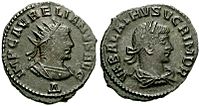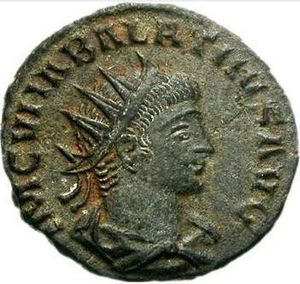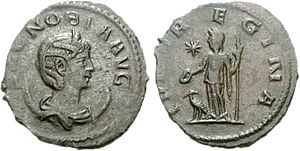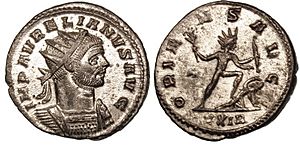Palmyrene Empire facts for kids
Quick facts for kids
Palmyrene Empire
|
|||||||||
|---|---|---|---|---|---|---|---|---|---|
| 270–273 | |||||||||
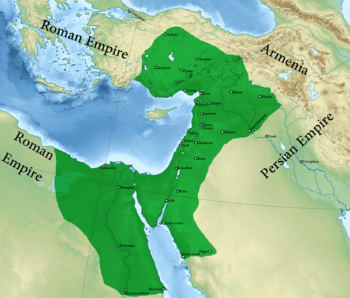
The Palmyrene Empire in 271
|
|||||||||
| Capital | Palmyra | ||||||||
| Largest city | Alexandria | ||||||||
| Common languages |
|
||||||||
| Government | Monarchy | ||||||||
| Monarch | |||||||||
|
• 267/270–272
|
Vaballathus | ||||||||
|
• 272–273
|
Zenobia | ||||||||
|
• 273–273
|
Antiochus | ||||||||
| Historical era | Late Antiquity | ||||||||
|
• Established
|
270 | ||||||||
|
• Disestablished
|
273 | ||||||||
|
|||||||||
The Palmyrene Empire was a powerful but short-lived kingdom that broke away from the Roman Empire. This happened during a very troubled time for Rome, known as the Crisis of the Third Century. The empire was named after its capital city, Palmyra. It included Roman areas like Syria Palaestina, Arabia Petraea, and Egypt. It also controlled large parts of Asia Minor.
Queen Zenobia ruled the Palmyrene Empire. She was officially the regent for her young son, Vaballathus. He became king in 267 when he was only ten years old. In 270, Zenobia quickly took over most of the Roman eastern lands. She tried to keep good relations with Rome, acting like a proper ruler. But in 271, she declared herself and her son emperors. This led to a short war with the Roman emperor Aurelian. He defeated Palmyra and captured Zenobia. A year later, the people of Palmyra rebelled again. This made Aurelian destroy the city of Palmyra.
Even though it lasted only a short time, the Palmyrene Empire is remembered. It was ruled by one of the most ambitious and powerful women of ancient times. Today, it is also seen as an important symbol in Syrian nationalism.
Contents
A Time of Trouble for Rome
After the Roman emperor Alexander Severus was killed in 235, Rome faced many problems. Many generals fought to become emperor, causing chaos. The empire's borders were left unprotected. Enemies like the Carpians, Goths, and Alemanni often attacked. The powerful Sassanids in the east also launched major attacks.
In 260, the Sassanid king Shapur I badly defeated the Romans. He even captured the Roman emperor Valerian. Soon after, two generals, Quietus and Macrianus, rebelled against Valerian's son, Gallienus. They took control of Syria.
The leader of Palmyra, Odaenathus, was declared king. He stayed loyal to Emperor Gallienus. Odaenathus gathered an army of Palmyrenes and Syrian farmers. He used this army to attack Shapur. In 260, Odaenathus won a big victory over Shapur near the Euphrates River. Next, in 261, Odaenathus defeated the rebel generals. He spent the rest of his rule fighting the Persians. Odaenathus was given the title Governor of the East. He ruled Syria as the emperor's representative. He also called himself King of Kings.
Odaenathus was killed along with his son Hairan in 267. Some ancient writers say his cousin, Maeonius, killed him. Maeonius might have tried to become emperor for a very short time. But he was likely killed right after assassinating Odaenathus.
Odaenathus's young son, Vaballathus, became king. He was only ten years old. His mother, Zenobia, became his regent. This meant she ruled in his place. Zenobia made sure her power was strong. She was careful not to anger Rome. She took the same titles her husband had. She also worked to keep the borders safe from Persia. And she calmed down the dangerous Tanukhid tribes in Hauran.
How the Empire Grew
In the spring of 270, Zenobia began a military campaign against the Tanukhids. This was during the rule of Emperor Claudius Gothicus. Her generals, Septimius Zabbai and Septimius Zabdas, helped her.
Zabdas attacked and destroyed Bosra. He killed the Roman governor there. Then he marched south and took control of Roman Arabia. Some stories say Zenobia herself attacked Dumat Al-Jandal. But she couldn't capture its castle. However, this story might be confusing Zenobia with another legendary Arab queen.
In October 270, a Palmyrene army of 70,000 soldiers invaded Egypt. Zenobia was declared queen of Egypt. The Roman general Tenagino Probus managed to take back Alexandria in November. But he was defeated and fled to the fortress of Babylon. There, he was surrounded and died after being captured by Zabdas. Zabdas continued his march south and secured all of Egypt.
Later, in 271, Zabbai began operations in Asia Minor. Zabdas joined him in the spring. The Palmyrenes took control of Galatia and occupied Ankara. This was the largest area the Palmyrene Empire ever controlled. However, they failed to conquer Chalcedon.
The Palmyrene conquests were made while still pretending to be loyal to Rome. Zenobia even made coins with the name of Claudius's successor, Aurelian. These coins showed Vaballathus as king. The emperor allowed these Palmyrene coins. He also let the Palmyrene rulers use their royal titles. But by the end of 271, Vaballathus took the title of Augustus (emperor). His mother, Zenobia, also took this title.
Rome Takes Back Control
In 272, Emperor Aurelian crossed the Bosporus strait. He quickly moved through Asia Minor. One story says that Marcus Aurelius Probus took Egypt back from Palmyra. Meanwhile, Aurelian continued his march and reached Tyana. The capture of Tyana became famous. Aurelian had destroyed every city that resisted him. But he spared Tyana after having a dream. In his dream, the great philosopher Apollonius of Tyana appeared. Apollonius told him: "Aurelian, if you want to rule, do not shed innocent blood! Aurelian, if you want to win, be kind!" Whatever the reason, Aurelian's kindness to Tyana helped him. Many more cities surrendered to him, seeing that he would not harm them.
Aurelian entered Issus and headed towards Antioch. He defeated Zenobia in the Battle of Immae. Zenobia retreated to Antioch, then fled to Emesa. Aurelian advanced and took Antioch. After gathering his forces, the Romans destroyed a Palmyrene army at Daphne. They then headed south to Apamea. Next, they continued to Emesa. There, they defeated Zenobia again at the Battle of Emesa. This forced her to go back to her capital city, Palmyra.
Aurelian marched through the desert. He was bothered by Bedouin tribes loyal to Palmyra. But as soon as he reached the city gates, he talked with the Bedouins. They then betrayed Palmyra. They supplied the Roman army with water and food. Aurelian surrounded Palmyra in the summer of 272. He tried to make a deal with Zenobia. He asked her to surrender in person. But she refused. The Romans tried to break through the city's defenses many times. But they were pushed back. As the situation got worse, Zenobia left the city. She headed east to ask the Persians for help. The Romans followed her. They captured her near the Euphrates River. They brought her back to the emperor. Soon after, the people of Palmyra asked for peace. The city surrendered.
What Happened Next
Aurelian spared the city of Palmyra. He left a group of 600 archers there to keep the peace. Their leader was named Sandarion. The city's defenses were destroyed. Most of its military equipment was taken away. Zenobia and her advisors were taken to Emesa for a trial. Most of the important Palmyrene officials were executed. What happened to Zenobia and Vaballathus is not fully known.
In 273, Palmyra rebelled again. A citizen named Septimius Apsaios led this revolt. He contacted the Roman governor of Mesopotamia, Marcellinus. Apsaios offered to help Marcellinus become emperor. Marcellinus delayed talking with them. He sent word to the Roman emperor instead. The rebels grew impatient. They declared a relative of Zenobia, named Antiochus, as emperor. Aurelian marched against Palmyra again. He was helped by a group inside the city. This group was led by a man named Septimius Haddudan.
Aurelian spared Antiochus. But he completely destroyed Palmyra. The emperor took the most valuable monuments. He used them to decorate his Temple of Sol in Rome. Buildings were smashed. People were beaten. Palmyra's holiest temple was robbed.
Zenobia's Legacy
Historians have different ideas about why Palmyra rebelled. Some think it was a fight for their own culture or people against Rome. Others believe it was because Rome was weak. They think Palmyra wanted to take advantage of Rome's problems.
Some scholars, especially Arab and Syrian ones, see Zenobia's revolt as a big Arab movement. They believe it was a step towards the later Arab expansion. Others disagree. They say it was more about Palmyra wanting to become the new center of the Roman Empire. Zenobia and Vaballathus used titles like "King of Kings," which were not Roman. But they also claimed Roman imperial titles. This suggests they might have wanted to rule the whole Roman Empire.
In the mid-1900s, interest in the Palmyrene Empire grew again. This was because of Syrian nationalism. Modern Syrian nationalists saw the empire as a unique Syrian civilization. They believed it tried to free the people of the Levant from Roman rule. A Syrian TV show was even made about Zenobia's life. Syria's former minister of defense, Mustafa Tlass, wrote a book about her.
|
See also
 In Spanish: Imperio de Palmira para niños
In Spanish: Imperio de Palmira para niños


